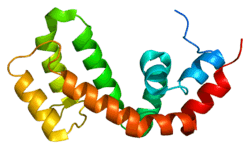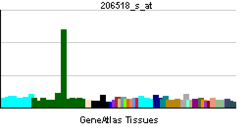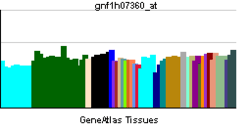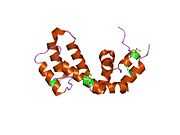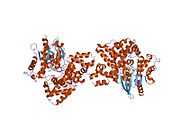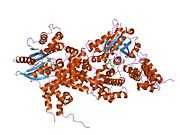RGS9
Regulator of G-protein signalling 9, also known as RGS9, is a human gene,[1] which codes for a protein involved in regulation of signal transduction inside cells. Members of the RGS family, such as RGS9, are signaling proteins that suppress the activity of G proteins by promoting their deactivation.[supplied by OMIM][1]
There are two splice isoforms of RGS9 with quite different properties and patterns of expression. RGS9-1 is mainly found in the eye and is involved in regulation of phototransduction in rod and cone cells of the retina, while RGS9-2 is found in the brain, and regulates dopamine and opioid signaling in the basal ganglia.[2]
RGS9-2 is of particular interest as the most important RGS protein involved in terminating signalling by the mu opioid receptor (although RGS4 and RGS17 are also involved), and is thought to be important in the development of tolerance to opioid drugs.[3][4][5][6][7][8][9] RGS9-deficient mice exhibit some motor and cognitive difficulties however, so inhibition of this protein is likely to cause similar side effects.[10]
RGS9 is differentially regulated by Guanine nucleotide-binding protein subunit beta-5 (GNB5) via the DEP domain and DEP helical-extension domain in protein stability and membrane anchor association.[11]
References
- ↑ 1.0 1.1 "Entrez Gene: RGS9 regulator of G-protein signalling 9".
- ↑ Martemyanov KA, Krispel CM, Lishko PV, Burns ME, Arshavsky VY (December 2008). "Functional comparison of RGS9 splice isoforms in a living cell". Proceedings of the National Academy of Sciences of the United States of America 105 (52): 20988–93. doi:10.1073/pnas.0808941106. PMC 2634932. PMID 19098104.
- ↑ Garzón J, Rodríguez-Díaz M, López-Fando A, Sánchez-Blázquez P (February 2001). "RGS9 proteins facilitate acute tolerance to mu-opioid effects". The European Journal of Neuroscience 13 (4): 801–11. doi:10.1046/j.0953-816x.2000.01444.x. PMID 11207815.
- ↑ Zachariou V, Georgescu D, Sanchez N, Rahman Z, DiLeone R, Berton O, Neve RL, Sim-Selley LJ, Selley DE, Gold SJ, Nestler EJ (November 2003). "Essential role for RGS9 in opiate action". Proceedings of the National Academy of Sciences of the United States of America 100 (23): 13656–61. doi:10.1073/pnas.2232594100. PMC 263869. PMID 14595021.
- ↑ Sánchez-Blázquez P, Rodríguez-Muñoz M, Montero C, Garzón J (January 2005). "RGS-Rz and RGS9-2 proteins control mu-opioid receptor desensitisation in CNS: the role of activated Galphaz subunits". Neuropharmacology 48 (1): 134–50. doi:10.1016/j.neuropharm.2004.08.016. PMID 15617734.
- ↑ Garzón J, Rodríguez-Muñoz M, López-Fando A, Sánchez-Blázquez P (March 2005). "Activation of mu-opioid receptors transfers control of Galpha subunits to the regulator of G-protein signaling RGS9-2: role in receptor desensitization". The Journal of Biological Chemistry 280 (10): 8951–60. doi:10.1074/jbc.M407005200. PMID 15632124.
- ↑ Psifogeorgou K, Papakosta P, Russo SJ, Neve RL, Kardassis D, Gold SJ, Zachariou V (October 2007). "RGS9-2 is a negative modulator of mu-opioid receptor function". Journal of Neurochemistry 103 (2): 617–25. doi:10.1111/j.1471-4159.2007.04812.x. PMID 17725581.
- ↑ Hooks SB, Martemyanov K, Zachariou V (January 2008). "A role of RGS proteins in drug addiction". Biochemical Pharmacology 75 (1): 76–84. doi:10.1016/j.bcp.2007.07.045. PMID 17880927.
- ↑ Traynor JR, Terzi D, Caldarone BJ, Zachariou V (March 2009). "RGS9-2: probing an intracellular modulator of behavior as a drug target". Trends in Pharmacological Sciences 30 (3): 105–11. doi:10.1016/j.tips.2008.11.006. PMC 3394094. PMID 19211160.
- ↑ Blundell J, Hoang CV, Potts B, Gold SJ, Powell CM (January 2008). "Motor coordination deficits in mice lacking RGS9". Brain Research 1190: 78–85. doi:10.1016/j.brainres.2007.11.017. PMC 2241663. PMID 18073128.
- ↑ Masuho, I.; Wakasugi-Masuho, H.; Posokhova, E. N.; Patton, J. R.; Martemyanov, K. A. (2011). "Type 5 G Protein Subunit (G 5) Controls the Interaction of Regulator of G Protein Signaling 9 (RGS9) with Membrane Anchors". Journal of Biological Chemistry 286 (24): 21806–21813. doi:10.1074/jbc.M111.241513. PMC 3122235. PMID 21511947.
Further reading
- Bonaldo MF, Lennon G, Soares MB (1997). "Normalization and subtraction: two approaches to facilitate gene discovery". Genome Res. 6 (9): 791–806. doi:10.1101/gr.6.9.791. PMID 8889548.
- Cowan CW, Fariss RN, Sokal I et al. (1998). "High expression levels in cones of RGS9, the predominant GTPase accelerating protein of rods". Proc. Natl. Acad. Sci. U.S.A. 95 (9): 5351–6. doi:10.1073/pnas.95.9.5351. PMC 20264. PMID 9560279.
- Granneman JG, Zhai Y, Zhu Z et al. (1998). "Molecular characterization of human and rat RGS 9L, a novel splice variant enriched in dopamine target regions, and chromosomal localization of the RGS 9 gene". Mol. Pharmacol. 54 (4): 687–94. PMID 9765512.
- Zhang K, Howes KA, He W et al. (2000). "Structure, alternative splicing, and expression of the human RGS9 gene". Gene 240 (1): 23–34. doi:10.1016/S0378-1119(99)00393-5. PMID 10564809.
- Yu H, Bondarenko VA, Yamazaki A (2001). "Inhibition of retinal guanylyl cyclase by the RGS9-1 N-terminus". Biochem. Biophys. Res. Commun. 286 (1): 12–9. doi:10.1006/bbrc.2001.5346. PMID 11485301.
- Hu G, Wensel TG (2002). "R9AP, a membrane anchor for the photoreceptor GTPase accelerating protein, RGS9-1". Proc. Natl. Acad. Sci. U.S.A. 99 (15): 9755–60. doi:10.1073/pnas.152094799. PMC 125004. PMID 12119397.
- Strausberg RL, Feingold EA, Grouse LH et al. (2003). "Generation and initial analysis of more than 15,000 full-length human and mouse cDNA sequences". Proc. Natl. Acad. Sci. U.S.A. 99 (26): 16899–903. doi:10.1073/pnas.242603899. PMC 139241. PMID 12477932.
- Martemyanov KA, Lishko PV, Calero N et al. (2003). "The DEP domain determines subcellular targeting of the GTPase activating protein RGS9 in vivo". J. Neurosci. 23 (32): 10175–81. PMID 14614075.
- Nishiguchi KM, Sandberg MA, Kooijman AC et al. (2004). "Defects in RGS9 or its anchor protein R9AP in patients with slow photoreceptor deactivation". Nature 427 (6969): 75–8. doi:10.1038/nature02170. PMID 14702087.
- Ajit SK, Young KH (2004). "Enhancement of pheromone response by RGS9 and Gbeta5 in yeast". Biochem. Biophys. Res. Commun. 324 (2): 686–91. doi:10.1016/j.bbrc.2004.09.100. PMID 15474482.
- Cheng JY, Luu CD, Yong VH et al. (2007). "Bradyopsia in an Asian man". Arch. Ophthalmol. 125 (8): 1138–40. doi:10.1001/archopht.125.8.1138. PMID 17698770.
| |||||||||||||
